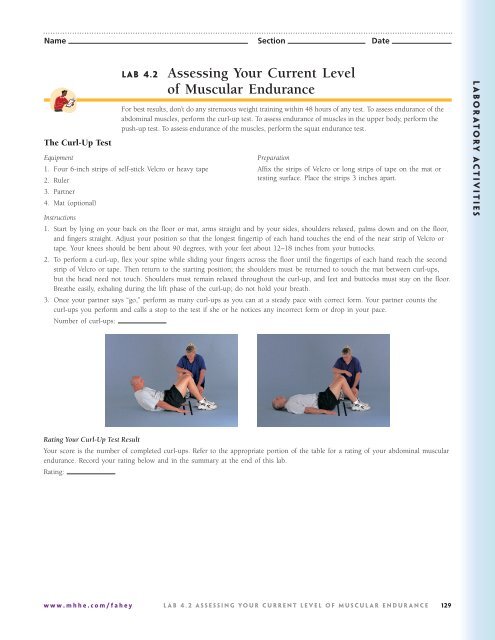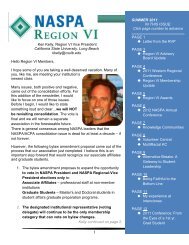LAB 4.2 Assessing Your Current Level of Muscular Endurance
LAB 4.2 Assessing Your Current Level of Muscular Endurance
LAB 4.2 Assessing Your Current Level of Muscular Endurance
You also want an ePaper? Increase the reach of your titles
YUMPU automatically turns print PDFs into web optimized ePapers that Google loves.
Name Section Date<br />
The Curl-Up Test<br />
Equipment<br />
Preparation<br />
1. Four 6-inch strips <strong>of</strong> self-stick Velcro or heavy tape Affi x the strips <strong>of</strong> Velcro or long strips <strong>of</strong> tape on the mat or<br />
2. Ruler<br />
testing surface. Place the strips 3 inches apart.<br />
3. Partner<br />
4. Mat (optional)<br />
Instructions<br />
1. Start by lying on your back on the fl oor or mat, arms straight and by your sides, shoulders relaxed, palms down and on the fl oor,<br />
and fi ngers straight. Adjust your position so that the longest fi ngertip <strong>of</strong> each hand touches the end <strong>of</strong> the near strip <strong>of</strong> Velcro or<br />
tape. <strong>Your</strong> knees should be bent about 90 degrees, with your feet about 12–18 inches from your buttocks.<br />
2. To perform a curl-up, fl ex your spine while sliding your fi ngers across the fl oor until the fi ngertips <strong>of</strong> each hand reach the second<br />
strip <strong>of</strong> Velcro or tape. Then return to the starting position; the shoulders must be returned to touch the mat between curl-ups,<br />
but the head need not touch. Shoulders must remain relaxed throughout the curl-up, and feet and buttocks must stay on the fl oor.<br />
Breathe easily, exhaling during the lift phase <strong>of</strong> the curl-up; do not hold your breath.<br />
3. Once your partner says “go,” perform as many curl-ups as you can at a steady pace with correct form. <strong>Your</strong> partner counts the<br />
curl-ups you perform and calls a stop to the test if she or he notices any incorrect form or drop in your pace.<br />
Number <strong>of</strong> curl-ups:<br />
Rating <strong>Your</strong> Curl-Up Test Result<br />
<strong>LAB</strong> <strong>4.2</strong> <strong>Assessing</strong> <strong>Your</strong> <strong>Current</strong> <strong>Level</strong><br />
<strong>of</strong> <strong>Muscular</strong> <strong>Endurance</strong><br />
For best results, don’t do any strenuous weight training within 48 hours <strong>of</strong> any test. To assess endurance <strong>of</strong> the<br />
abdominal muscles, perform the curl-up test. To assess endurance <strong>of</strong> muscles in the upper body, perform the<br />
push-up test. To assess endurance <strong>of</strong> the muscles, perform the squat endurance test.<br />
<strong>Your</strong> score is the number <strong>of</strong> completed curl-ups. Refer to the appropriate portion <strong>of</strong> the table for a rating <strong>of</strong> your abdominal muscular<br />
endurance. Record your rating below and in the summary at the end <strong>of</strong> this lab.<br />
Rating:<br />
www.mhhe.com/fahey <strong>LAB</strong> <strong>4.2</strong> ASSESSING YOUR CURRENT LEVEL OF MUSCULAR ENDURANCE 129<br />
<strong>LAB</strong>ORATORY ACTIVITIES
<strong>LAB</strong>ORATORY ACTIVITIES<br />
Ratings for the Curl-Up Test<br />
The Push-Up Test<br />
Equipment: Mat or towel (optional)<br />
Preparation<br />
In this test, you will perform either standard push-ups or modifi ed push-ups, in which you support yourself with your knees. The<br />
Cooper Institute developed the ratings for this test with men performing push-ups and women performing modifi ed push-ups. Biologically,<br />
males tend to be stronger than females; the modifi ed technique reduces the need for upper-body strength in a test <strong>of</strong> muscular<br />
endurance. Therefore, for an accurate assessment <strong>of</strong> upper-body endurance, men should perform standard push-ups and women<br />
should perform modifi ed push-ups. However, in using push-ups as part <strong>of</strong> a strength training program, individuals should choose the<br />
technique most appropriate for increasing their level <strong>of</strong> strength and endurance—regardless <strong>of</strong> gender.<br />
Instructions<br />
1. For push-ups: Start in the push-up<br />
position with your body supported<br />
by your hands and feet. For-modifi ed<br />
push-ups: Start in the modifi ed pushup<br />
position with your body<br />
supported by your hands and knees.<br />
For both positions, keep your arms<br />
and your back straight and your<br />
fi ngers pointed forward.<br />
2. Lower your chest to the fl oor with your back straight, and then return to the starting position.<br />
3. Perform as many push-ups or modifi ed push-ups as you can without stopping.<br />
Number <strong>of</strong> push-ups: or number <strong>of</strong> modifi ed push-ups:<br />
Rating <strong>Your</strong> Push-Up Test Result<br />
Number <strong>of</strong> Curl-Ups<br />
Men Very Poor Poor Average Good Excellent Superior<br />
Age: 16–19 Below 48 48–57 58–64 65–74 75–93 Above 93<br />
20–29 Below 46 46–54 55–63 64–74 75–93 Above 93<br />
30–39 Below 40 40–47 48–55 56–64 65–81 Above 81<br />
40–49 Below 38 38–45 46–53 54–62 63–79 Above 79<br />
50–59 Below 36 36–43 44–51 52–60 61–77 Above 77<br />
60–69<br />
Women<br />
Below 33 33–40 41–48 49–57 58–74 Above 74<br />
Age: 16–19 Below 42 42–50 51–58 59–67 68–84 Above 84<br />
20–29 Below 41 41–51 52–57 58–66 67–83 Above 83<br />
30–39 Below 38 38–47 48–56 57–66 67–85 Above 85<br />
40–49 Below 36 36–45 46–54 55–64 65–83 Above 83<br />
50–59 Below 34 34–43 44–52 53–62 63–81 Above 81<br />
60–69 Below 31 31–40 41–49 50–59 60–78 Above 78<br />
SOURCE: Ratings based on norms calculated from data collected by Robert Lualhati on 4545 college students, 16–80 years <strong>of</strong> age, at Skyline College,<br />
San Bruno, California. Used with permission.<br />
<strong>Your</strong> score is the number <strong>of</strong> completed push-ups or modifi ed push-ups. Refer to the appropriate portion <strong>of</strong> the table for a rating <strong>of</strong><br />
your upper-body endurance. Record your rating below and in the summary at the end <strong>of</strong> this lab.<br />
Rating:<br />
130 CHAPTER 4 MUSCULAR STRENGTH AND ENDURANCE
Ratings for the Push-Up and Modifi ed Push-Up Tests<br />
Number <strong>of</strong> Squats Performed<br />
Below Above<br />
Men Very Poor Poor Average Average Average Good Excellent<br />
Age 18–25 ,25 25–30 31–34 35–38 39–43 44–49 .49<br />
26–35 ,22 22–28 29–30 31–34 35–39 40–45 .45<br />
36–45 ,17 17–22 23–26 27–29 30–34 35–41 .41<br />
46–55 ,9 13–17 18–21 22–24 25–38 29–35 .35<br />
56–65 ,9 9–12 13–16 17–20 21–24 25–31 .31<br />
651 ,7 7–10 11–14 15–18 19–21 22–28 .28<br />
Below Above<br />
Women Very Poor Poor Average Average Average Good Excellent<br />
Age 18–25 ,18 18–24 25–28 29–32 33–36 37–43 .43<br />
26–35 ,20 13–20 21–24 25–28 29–32 33–39 .39<br />
36–45 ,7 7–14 15–18 19–22 23–26 27–33 .33<br />
46–55 ,5 5–9 10–13 14–17 18–21 22–27 .27<br />
56–65 ,3 3–6 7–9 10–12 13–17 18–24 .24<br />
651 ,2 2–4 5–10 11–13 14–16 17–23 .23<br />
SOURCE: www.topendsports.com/testing/tests/home-squat.htm<br />
Number <strong>of</strong> Push-Ups<br />
Men Very Poor Poor Fair Good Excellent Superior<br />
Age: 18–29 Below 22 22–28 29–36 37–46 47–61 Above 61<br />
30–39 Below 17 17–23 24–29 30–38 39–51 Above 51<br />
40–49 Below 11 11–17 18–23 24–29 30–39 Above 39<br />
50–59 Below 9 9–12 13–18 19–24 25–38 Above 38<br />
60 and over Below 6 6–9 10–17 18–22 23–27 Above 27<br />
Number <strong>of</strong> Modifi ed Push-Ups<br />
Women Very Poor Poor Fair Good Excellent Superior<br />
Age: 18–29 Below 17 17–22 23–29 30–35 36–44 Above 44<br />
30–39 Below 11 11–18 19–23 24–30 31–38 Above 38<br />
40–49 Below 6 6–12 13–17 18–23 24–32 Above 32<br />
50–59 Below 6 6–11 12–16 17–20 21–27 Above 27<br />
60 and over Below 2 2–4 5–11 12–14 15–19 Above 19<br />
SOURCE: Based on norms from The Cooper Institute <strong>of</strong> Aerobic Research, Dallas, Texas; from The Physical Fitness Specialist Manual, revised 2002.<br />
Used with permission.<br />
The Squat <strong>Endurance</strong> Test<br />
Instructions<br />
1. Stand with your feet placed slightly more than shoulder width apart, toes pointed out slightly,<br />
hands on hips or across your chest, head neutral, and back straight. Center your weight over<br />
your arches or slightly behind.<br />
2. Squat down, keeping your weight centered over your arches, until your thighs are parallel with<br />
the fl oor. Push back up to the starting position, maintaining a straight back and neutral head<br />
position.<br />
3. Perform as many squats as you can without stopping.<br />
Number <strong>of</strong> squats:<br />
Rating <strong>Your</strong> Squat <strong>Endurance</strong> Test Result<br />
<strong>Your</strong> score is the number <strong>of</strong> completed squats. Refer to the appropriate portion <strong>of</strong> the table for a<br />
rating <strong>of</strong> your leg muscular endurance. Record your rating below and in the summary at the end<br />
<strong>of</strong> this lab.<br />
Rating:<br />
Ratings for the Squat <strong>Endurance</strong> Test<br />
www.mhhe.com/fahey <strong>LAB</strong> <strong>4.2</strong> ASSESSING YOUR CURRENT LEVEL OF MUSCULAR ENDURANCE 131<br />
<strong>LAB</strong>ORATORY ACTIVITIES
<strong>LAB</strong>ORATORY ACTIVITIES<br />
Summary <strong>of</strong> Results<br />
Curl-up test: Number <strong>of</strong> curl-ups: Rating:<br />
Push-up test: Number <strong>of</strong> push-ups: Rating:<br />
Squat endurance test: Number <strong>of</strong> squats: Rating:<br />
Remember that muscular endurance is specifi c: <strong>Your</strong> ratings may vary considerably for different parts <strong>of</strong> your body.<br />
Using <strong>Your</strong> Results<br />
How did you score? Are you surprised by your ratings for muscular endurance? Are you satisfi ed with your current ratings?<br />
If you’re not satisfi ed, set realistic goals for improvement:<br />
Are you satisfi ed with your current level <strong>of</strong> muscular endurance as evidenced in your daily life—for example, your ability to carry groceries<br />
or your books, hike, and do yard work?<br />
If you’re not satisfi ed, set realistic goals for improvement:<br />
What should you do next? Enter the results <strong>of</strong> this lab in the Preprogram Assessment column in Appendix D. If you’ve set goals for improvement,<br />
begin planning your strength training program by completing the plan in Lab 4.3. After several weeks <strong>of</strong> your program, complete<br />
this lab again and enter the results in the Postprogram Assessment column <strong>of</strong> Appendix D. How do the results compare?<br />
132 CHAPTER 4 MUSCULAR STRENGTH AND ENDURANCE









